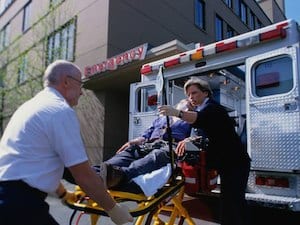
FRIDAY, Jan. 26, 2018 (HealthDay News) — If you call 911, you expect to get the medical services you need.
But new research suggests that when it comes to severe low blood sugar episodes in people with diabetes, first responders might not be able to administer a potentially lifesaving medication called glucagon.
Glucagon is an injectable medication that prompts the liver to release stored glucose. This quickly raises blood sugar.
“In most states, basic EMTs [emergency medical technicians] cannot administer glucagon,” said study senior author Dr. Robert Gabbay, chief medical officer at the Joslin Diabetes Center in Boston.
But paramedics can give the injections, said Dr. Craig Manifold, medical director of the National Association of Emergency Medical Technicians. That’s because paramedics get between 750 and 1,500 hours of education compared to about 100 to 150 hours of training for EMTs.
Low blood sugar levels (hypoglycemia) generally occur in people with type 1 or type 2 diabetes taking insulin or other blood sugar-lowering medications. Researchers said more than 100,000 serious hypoglycemia episodes occur each year.
Gabbay noted even U.S. Supreme Court justices aren’t immune to this problem. Earlier this month, Justice Sonia Sotomayor, who has type 1 diabetes, had to call emergency services for help with serious low blood sugar.
Early symptoms include shakiness, confusion and sweating. Left untreated, low blood sugar can cause seizures, unconsciousness and even death, according to the American Diabetes Association (ADA).
These episodes can usually be treated with a food or drink containing fast-acting carbohydrates, such as glucose tablets, juice or sugar-sweetened soda, the ADA said.
Sometimes the episodes are more serious and require glucagon. People with diabetes at risk of hypoglycemia may have their own emergency glucagon kit. But many don’t. The study found that of more than 11 million Medicare patients with diabetes, just 0.2 percent had a glucagon kit.
Ideally, family members are trained to use the kit. This involves mixing a dry powder with a sterile fluid. Then the proper dose needs to be drawn into a syringe and injected into muscle tissue. Everything that’s needed — including instructions — is in the kit.
Only eight states (Alaska, Illinois, Kansas, Minnesota, Montana, Rhode Island, Virginia and Wisconsin) and Washington, D.C., let EMTs give glucagon, the study found. Forty-one states don’t allow EMTs to give glucagon, and Texas doesn’t set specific standards.
Nationwide, there are 198,000 EMTs and about 61,000 paramedics. That means there’s a 75 percent chance that a responder won’t be able to give a potentially lifesaving treatment, researchers said.
Bryan Edwards, director of the Union EMS from Carolinas Healthcare, said those numbers don’t necessarily mean that only EMTs respond to an emergency call.
“In North Carolina, the state controls the ambulance services. When someone calls, they’re asked a series of questions and will send a paramedic when needed,” he explained.
But that doesn’t seem to happen in all states, the study found. Of nearly 90,000 cases where glucagon was given before the hospital, emergency dispatchers correctly coded the calls as a “diabetic problem” only about 45 percent of the time.
Almost 4,000 of those people had side effects from the glucagon injection. The most common reactions were nausea and vomiting, Gabbay said.
The cost of a glucagon kit is around $212. Gabbay noted that compared to an ER visit (average cost nearly $1,500) or a hospital admission (average cost of almost $19,000) for hypoglycemia, glucagon is quite cost-effective.
But in these days of tight government budgets, Manifold said the cost of the kits can sometimes limit their use.
Edwards said that in North Carolina, the decision on what medications to stock an ambulance with is made at the county level.
“Every county carries different medications that are usually chosen based on historical needs,” he said.
For example, in Charlotte, there are a lot of hospitals nearby, so those ambulances don’t need to carry as much medication. But in the surrounding areas, where ambulance transport times are longer, they may carry more medications, Edwards added.
Gabbay recommended that anyone at risk of hypoglycemia should have a glucagon kit. He said this is especially important for people who no longer feel the symptoms of low blood sugar — a condition known as hypoglycemia unawareness.
The study appeared recently in the Annals of Internal Medicine.
More information
Learn more about low blood sugar from the American Diabetes Association.
